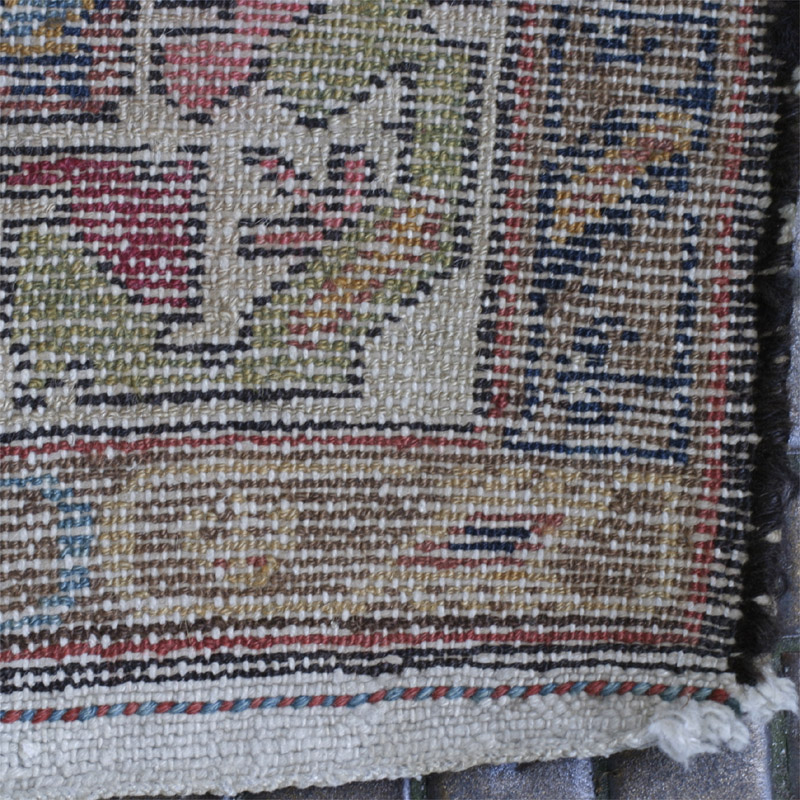Click on image to view at larger size
View rug in extra large size (warning: large image!!, 1.5 MB).
The attribution in the catalogue of the auction house had this one down as Malayer. I was not convinced but I consulted a number of rug books to find some Malayer at least vaguely similar to this one. Then, I discovered why this rug had appeared strangely familiar to me: Willborg shows an almost identical companion to this rug (though not identical down to the fine details as in a cartoon-based design) as plate 9 in his little book 'Hamadan', and attributes it to the Kharaghan district, ca. 100 km north-east of Hamadan. Other, though later and much less successful (harsher, coarser, less balanced) examples of Gharaghan rugs are shown by Ford in fig. 556 and 557 (he renders the name as 'Kharaghan'). The commonality of the type, which is considered particularly Kurdish, is the bold angular design, the heavy hooked medallion and the spiky spandrels. I do not know whether in fact there are any Kurds so far north-east of Hamadan (see map below), but I am happy to leave it undecided whether this was woven by Kurds or another ethnic group. Willborg gives 1910–1925 as a origin date range for his piece, I guess the same is likely for this one.
The triple or multiple outlining (the medallion is outlined by green-orange-green, and the rectangular petals of the abstract flower in the centre of the medallion have similarly strong multiple outlines) lends a very vibrant note to this rug. It is certainly not a refined piece, it shouts!
I wonder whether the motif in the centre of the rug represents a hand—does it perhaps represent the Hamsa charm, also called Fatima's hand? The flower in the centre of the 'hand' does not really look like an eye, however.

Ethnic mix of Hamadan area. The Gharaghan district sems to be mostly inhabited by Persian and Azerbaijani people, and by the Shahsavan. According to this map (which may be wrong of course), there aren't many Kurds to the north-east of Hamadan.
This is a very dense and heavy rug, with full, quite long pile, so the design seems a bit fuzzy. It has symmetric knots and is single-wefted as uaual for the Hamadan area. In order to compare structure with Willborg's lookalike, I had to count knots to the decimeter and arrived at a slightly lower figure than Willborg's v.31/10cm, h.31/10cm (= 810 knots/dm2) count (which, converted to inches, equals ca. h.8,v.8 = 64 kpsi). On this one, I counted h.27/10, v.30/10 (= 810 knots/dm2 or, converted to to inches, h.7,v.7,5 = ca. 53 kpsi). Willborg identifies one cotton weft and one brown wool weft in the same shed, I can only see cotton on the back of this one. Warps are of course also cotton.
I like the bright and lively candy-coloured palette, which is well balanced and probably based on natural dyes apart from the strong blueish red. I feel that the light blue, rose, light green, strong red and dark blue harmonise well. The red is very close to cochenille red. This dye is fast and has no tip fading, there is not a trace of bleeding and a wet white cloth rubbed over it stays white.
Nice condition, full pile, a very heavy and sturdy rug. No holes or wear. Has not been washed, but is not really dirty. I can see no issues with this piece apart from spome loss of some of the brown wrapping of the selvage at the top left. Even the ends are nicely preserved, with the red-green and red-blue decoration lines intact.




